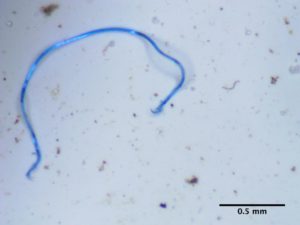 It turns out that we're all eating tiny bits of plastic in our food. Yes, teeny tiny bits of plastic that are smaller than 5 mm and are called microplastics. Why are there tiny plastic pieces in our food? Is it doing anything to us, to our health? What can we do about it? After all, it's not normal or desirable to eat plastic.
It turns out that we're all eating tiny bits of plastic in our food. Yes, teeny tiny bits of plastic that are smaller than 5 mm and are called microplastics. Why are there tiny plastic pieces in our food? Is it doing anything to us, to our health? What can we do about it? After all, it's not normal or desirable to eat plastic.
Most of us have heard of the "garbage patches" in the oceans - consisting of many pieces of plastic debris, both big and small. But the reality is that tiny pieces of plastic are all around us, not just far away in the ocean. Microplastics can be found in our drinking water, bottled water, in the seafood we eat, in honey and sugar, in beer, table salt, even in our house dust (which includes tiny synthetic fibers, such as polyester, that are constantly being shed from soft furnishings, clothing, and carpet fibers), and outside air (e.g. from tires). This is microplastic pollution, and unfortunately this pollution is increasing each year because we are increasing our use of plastics. [Other posts on this topic here, here, here.]
Every time we eat a meal we ingest any plastics that are in the food, as well as any plastic particles floating in the air that settle on our food and which we then ingest. One recent study found that about 80 to 100 pieces of tiny plastic particles are eaten over the course of each meal in this way!
Currently no one knows what ingesting all these microplastics is doing to us, if anything. The research hasn't been done. However, there are questions and concerns, especially because toxic chemicals (carcinogens, endocrine disruptors, etc) used in plastic manufacturing are in the microplastics, as well as any contaminants that the plastics were exposed to in the environment. There may even be microbes (including pathogens) on the plastics. A recent study found that we excrete microplastics in our feces.
A 2017 United Nations report about microplastics and food safety said that while much remains unknown, microplastics in our food doesn't appear to be health threat: "It is thought that only the smallest particles (1.5 µm or less) will penetrate into the capillaries of the organs and the remaining will be excreted." and "Based on the available scientific evidence, it is safe to state that microplastics neither seem to pose a significant food safety threat and the health benefits associated with the intake of fishery products will exceed the potential risks.Nonetheless, there are many knowledge gaps..."
From National Geographic: Microplastics found in 90 percent of table salt
Microplastics were found in sea salt several years ago. But how extensively plastic bits are spread throughout the most commonly used seasoning remained unclear. Now, new research shows microplastics in 90 percent of the table salt brands sampled worldwide. Of 39 salt brands tested, 36 had microplastics in them, according to a new analysis by researchers in South Korea and Greenpeace East Asia.
Salt samples from 21 countries in Europe, North and South America, Africa, and Asia were analyzed. The three brands that did not contain microplastics are from Taiwan (refined sea salt), China (refined rock salt), and France (unrefined sea salt produced by solar evaporation). The study was published this month in the journal Environmental Science & Technology.
The density of microplastics found in salt varied dramatically among different brands, but those from Asian brands were especially high, the study found. The highest quantities of microplastics were found in salt sold in Indonesia. Asia is a hot spot for plastic pollution, and Indonesia—with 34,000 miles (54,720 km) of coastline—ranked in an unrelated 2015 study as suffering the second-worst level of plastic pollution in the world.
In another indicator of the geographic density of plastic pollution, microplastics levels were highest in sea salt, followed by lake salt and then rock salt.
The new study estimates that the average adult consumes approximately 2,000 microplastics per year through salt. What that means remains a mystery.
Excerpt from a study by Luís Gabriel Antão Barboza et al: Marine microplastic debris: An emerging issue for food security, food safety and human health
Scientists speculate that microplastics with size bigger than 150 μm probably will not be absorbed while microplastics smaller than 150 μm may translocate from the gut cavity to the lymph and circulatory system, causing systemic exposure. However, the absorption of these microplastics is expected to be limited (≤0.3%). Only microplastics with size ≤ 20 μm would be able to penetrate into organs while the smallest fraction (0.1 > 10 μm) would be able to access all organs, cross cell membranes, the blood-brain barrier and the placenta – Fig. 1(Browne et al., 2008; von Moos et al., 2012; Bouwmeester et al., 2015; Galloway, 2015; EFSA, 2016; Lusher et al., 2017). If so, it is possible that the distribution of microplastics in secondary tissues, such as liver, muscle, and brain, may occur (Wright and Kelly, 2017). Moreover, it is expected that micro- and nanoplastic interactions with the immune system may potentially lead to immunotoxicity and consequently trigger adverse effects (i.e. immunosuppression, immune activation and abnormal inflammatory responses) (Lusher et al., 2017; Wright and Kelly, 2017).
